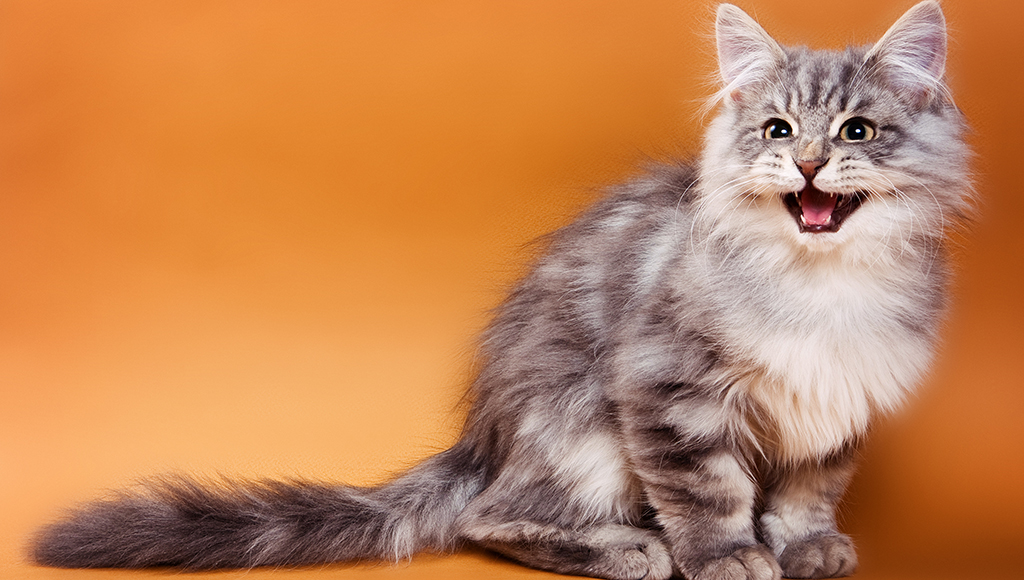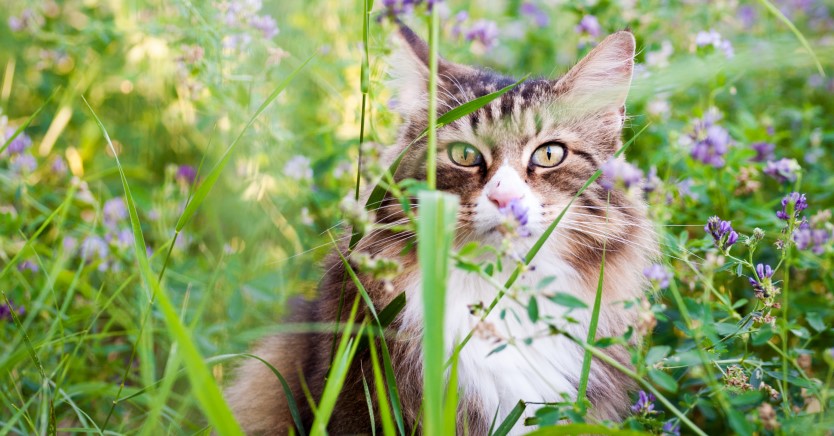Do Cats Have Their Own Language?
Cats communicate with other animals and their owners with a variety of sounds.

A feline's vocal apparatus differs from our own and is not designed with actual speech in mind. However cats still need to communicate, both with other cats and animals and with their human companions too. Cats "speak" to each other through body language, communicating feelings and intentions through posture and facial expression as well as sound. Humans do this too, but are able to rely more on on verbal expression because of their ability to talk.
Scent is also an important component of cat communication. In addition, Cats have a vocabulary of sounds ranging from caterwauls to mewing sounds, from hisses to the "silent meow" which is probably a sound pitched too high for human ears to hear.
Cats make a variety of different sounds which some people might call "words." While these are not "words," in a grammatical sense, they do comprise a cat's language. Below are some interpretations of the various noises and vocalizations cats use:
Kittens:
- Mew (high pitched and thin) - a polite plea for help
- MEW! (loud and frantic) - an urgent plea for help
Adult cats:
- mew - plea for attention
- mew (soundless) - a very polite plea for attention which is often a sound pitched too high for human ears and barely heard
- meow - emphatic plea for attention
- MEOW! - a command!
- mee-o-ow (with falling cadence) - protest or whine
- MEE-o-ow (shrill whine) - stronger protest
- MYUP! (short, sharp, single note) - righteous indignation
- MEOW! Meow! (repeated) - panicky call for help
- mier-r-r-ow (chirrup with lifting cadence) - friendly greeting
Tomcats:
- RR-YOWWW-EEOW-RR-YOW-OR - caterwaul
- merrow - challenge to another male
- meriow - courting call to female
Mother cats:
- MEE-OW - come and get it!
- meOW - follow me!
- ME R-R-R-ROW - take cover!
- mer ROW! - No! or Stop It!
- mreeeep (burbled) - hello greeting to kittens and disarming greeting to adult cats (also used between adult cats and humans)
There is more to felinese than the simple miaow though. In 1944, Mildred Moelk made a detailed study of cat vocabulary and found sixteen meaningful sounds, which included consonants and vowels. She divided cat-sounds into three groups:
- murmurs made with the mouth closed
- vowel sounds made with the mouth closing as in "iao"
- sounds made with the mouth held open.
Although these may not be used in grammatical sentences, one definition of language is "any means, vocal or other, of expressing or communicating feeling or thought" (Webster's Dictionary). Observant owners will notice the following sounds which cats make to communicate their state of mind. This list is not exhaustive, since cats have individual personalities and will improvise:
- Caterwaul - cat wants sex!
- Chatter - excitement, frustration e.g. when prey is out of reach or escapes (involves rapid teeth-chattering jaw movements). Another suggestion for teeth chattering, in outdoor cats at least, is to make their prey curious enough to overcome caution.
- Chirrup - friendly greeting sound, a cross between a meow and a purr! (friendly greeting sound with rising inflection; familiar to most cat owners)
- Cough-bark - alarm signal (rare in pet cats); like us, cats can cough both voluntarily and involuntarily)
- Growl - threat, challenge, warns others to go away
- Hiss (with or without spit) - threat, fear, warns others to back off
- Meow - general purpose attention seeking sound used by adult cats to communicate with owners or with kittens
- Mew (of kittens) - distress, hunger, cold (to attract mother's attention)
- Purr - contentment, relaxation, also to comfort itself if in pain (cats in great physical distress, even near death may purr); a loud purr invites close contact or attention
- Scream - fear, pain, anger, distress
- Squawk - surprise, shock (somewhat strangled sound)
- Yowl - a threat, offensive or defensive, but also used in a modified form by some cats seeking attention when owner is out of sight
- Idiosyncratic sounds - a sound which a particular cat uses in a particular context.
- Squabble - a series of short and long meows and grunts made in a complaining tone that occur when a cat is moved or made to do something it would rather not do
The exact meanings of all of these sounds may be modified or emphasized by facial expression, tone/volume, frequency and body language depending on the current situation. Some cats may use some of these cat-sounds in different ways when communicating with humans and only our familiarity with our own pets tells us for instance that a certain type of growl is a playful noise and not warning of imminent attack.
One feature common to both cats and people is the use of a slightly raised tone of voice to indicate friendliness and a lowered tone of voice to indicate displeasure, aggression etc. Friendly chirrup and food-seeking miaow are usually uttered in a raised tone of voice while the low-pitched growl of a cross cat is undeniably unfriendly.
Volume is sometimes used for added emphasis (e.g. a strident miaow for urgency, a gentle "burp" for contentment). Cats which simply feel compelled to add their personal point-of-view to a conversation often do so in a neutral tone of voice to indicate that they are not being particularly hostile, nor unduly friendly, and that there is no great urgency about the subject matter.
Are some breeds more talkative than others?
Siamese cats are well known for being quite vocal, but are often simply dismissed as noisy, yowling cats. Siamese vocabulary includes "a very long mew of medium pitch" which is often emitted soon after the cat is let into a room. This is possibly purely conversational, serving to inform those in the room that it has arrived and is passing the time of day. A far more plaintive sound is made when cats wish to be let in or out, or to attract attention to themselves if they feel they have been unjustly ignored.
Burmese are also a very vocal breed, but as a result of having a slightly narrower range of pitch than the Siamese, they rely more on variations in length and volume of their mews to provide a large number of different ‘remarks’. In contrast, British Short hairs tend to show the reserve traditionally attributed to their human counterparts; they vocalize a lot less than the Oriental breeds, and their mews, when uttered, are usually quite brief. However; though brief, a range of pitches can still be detected. Sharp sounds generally signify distress or impatience, while those of medium pitch are used for less urgent situations such as polite request for food. A mew emitted whilst purring usually means the animal is contented.
Long-haired breeds, on the whole, have rather high-pitched voices, and unless they are extremely upset the volume of their mews is fairly low. In their attempts to communicate with us on our own level, some cats put together full "sentences" of noises and pauses. They might simply be inviting us to talk back to them as most cats really enjoy this sort of attention and interaction from their owners.
What does a cat's purr mean?
Purring is caused by vibration of structures in the throat. Although not strictly a vocalization, the purr is an important means of communication, and depending upon the cat's situation, it can convey contentment, pleasure or be placatory behavior (i.e. "I am not a threat to you"). As well as purring when happy, cats also purr when severely injured, frightened or giving birth. A cat may even purr when close to death.
It is also believed that the familiar purr generally associated with contentment, is also exhibited by a cat when he is being restrained for veterinary procedures (blood samples or X-rays). The inference drawn from this behavior is the cat indicating that he is tractable and co-operative and does not need to be forcibly handled. This purr is likened to behavior of a subsmissive cat attempting to avoid conflict with a larger, more powerful animal or human.
Ready to start saving money on pet wellness care?
Then take a look at Mint Wellness, the pet wellness plan that provides fast reimbursement on routine pet care. Save on vaccinations, wellness exams, preventatives, dental, and more!
Learn More

